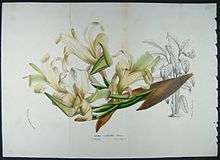Canna liliiflora
| Canna liliiflora | |
|---|---|
 | |
| Canna liliiflora, only white, perfumed canna. | |
| Scientific classification | |
| Kingdom: | Plantae |
| (unranked): | Angiosperms |
| (unranked): | Monocots |
| (unranked): | Commelinids |
| Order: | Zingiberales |
| Family: | Cannaceae |
| Genus: | Canna |
| Species: | C. liliiflora |
| Binomial name | |
| Canna liliiflora Warsc. ex Planch. | |
Canna liliiflora is a species of the Canna genus, a member of the family Cannaceae, and a native of Peru and Bolivia. It is a perennial growing to 3m. It is hardy to zone 10 and is frost tender. In the north latitudes it is in flower from August to October, and the seeds ripen in October. The flowers are hermaphrodite (have both male and female organs).
Synonyms
- Canna brittoni Rusby.
- Lily Canna
- Scented Canna
- White Canna
Taxonomy
In the last three decades of the 20th century, Canna species have been categorised by two different taxonomists, Paulus Johannes Maria Maas from the Netherlands and Nobuyuki Tanaka from Japan. Both taxonomists are in agreement that C. liliiflora is a distinct and separate species.
Canna liliiflora Warsc. ex Planch.
(Lily-flowered). Flower 10–13 cm. (4-5") long, Honeysuckle-scented, in a short, terminal raceme; perianth tubular, the three outer petaloid lobes linear-oblong, convolute, reflexed, tinged green, the three inner ones straight and extended, recurved at end, white, tinted yellowish-green. Leaves large, Musa-like, oblong, acuminate. Stems stout, erect. Height 2–3 metres (6-10feet) A fine plant. (F.d.S. 1055-6; R. H. 1884, 132.)
Cultivation
The species prefers light (sandy), medium (loamy) and heavy (clay) soils and requires well-drained soil. The preferred soil is acid, neutral and basic (alkaline). It cannot grow in the shade and requires moist soil.
References
- The illustration is from Flore des serres et des jardins de l’Europe by Charles Lemaire and others. Gent, Louis van Houtte, 1855, volume 10 (plate 1055-1056).
- Cooke, Ian, 2001. The Gardener's Guide to Growing cannas, Timber Press. ISBN 0-88192-513-6
- Johnson's Gardeners Dictionary, 1856
- Tanaka, N. 2001. Taxonomic revision of the family Cannaceae in the New World and Asia. Makinoa ser. 2, 1:34–43.